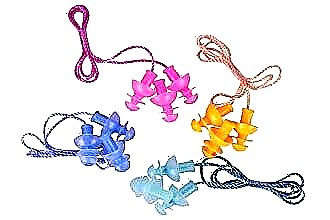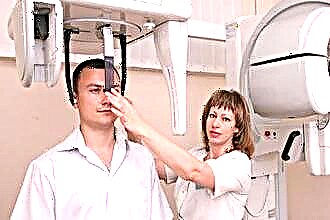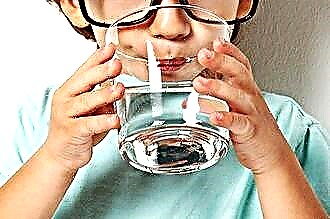Water in the ear almost immediately causes uncomfortable sensations - a sharp deterioration in hearing, congestion and extraneous noise. Untimely elimination of the fluid can cause the development of catarrhal processes in the external ear canal, membrane and parts of the middle ear. Septic inflammation contributes to the development of ear diseases, which include otitis media, myringitis, eustachitis, etc.
 "Swimmer's ear", i.e. a bacterial infection localized in the outer ear occurs due to the penetration of pathogens into the ear canal. In the presence of minor mechanical injuries (abrasions, scratches) in the ear, complications often arise that entail auditory dysfunction, conductive or sensorineural hearing loss.
"Swimmer's ear", i.e. a bacterial infection localized in the outer ear occurs due to the penetration of pathogens into the ear canal. In the presence of minor mechanical injuries (abrasions, scratches) in the ear, complications often arise that entail auditory dysfunction, conductive or sensorineural hearing loss.
Is congestion dangerous?
What if water gets into my ear? In the absence of ear diseases and perforated holes in the tympanic membrane, you should not be afraid of the penetration of liquid into the external ear canal. There is a sufficient amount of sulfur inside the ear, which prevents moisture from penetrating into the bony part of the auditory canal.
Even if water gets deep into the ear canal, its penetration into the tympanic cavity is excluded. Between the outer and middle ear is the eardrum, which is a waterproof membrane. It serves two important functions:
- prevents the penetration of water and pathogens into the auditory analyzer;
- enhances audio signals from the environment.
According to experts, it is necessary to be wary of moisture penetration into the ear when:
- accumulation of sulfur masses in the ear - the penetration of liquid into the ear canal contributes to the swelling of sulfur plugs, which is fraught with damage to the skin and, accordingly, the development of external otitis media;
- transferring otitis media - as a result of perforation, the tympanic membrane heals for a long time, which can contribute to the penetration of moisture into the middle ear cavity;
- reduced body resistance - water contains opportunistic organisms, which, when the immune defense is weakened, provoke septic inflammation in the soft tissues of the auditory analyzer;
- hypersensitivity of the skin - water in the ear often causes an allergic reaction, accompanied by swelling of the mucous membrane in the ear canal.
If the uncomfortable sensations in the ear persist within 3-4 days, you need to be examined by an ENT doctor.
Symptomatic picture
How do you know if water gets into your ear? As a rule, adults accurately determine the presence of fluid in the external part of the auditory analyzer. The following signs indicate the accumulation of moisture in the ear:
 congestion - water creates pressure on the ear membrane, resulting in a feeling of congestion;
congestion - water creates pressure on the ear membrane, resulting in a feeling of congestion;- a decrease in the hearing threshold - the fluid in the ear canal is a mechanical obstacle to the passage of sound waves, as a result of which hearing impairment is observed;
- autophony - a water plug in the ear canal leads to the occurrence of audiological disorders leading to a distorted perception of one's own voice;
- noises in the ear - when the position of the body changes, the intensity of water pressure on the ear membrane changes, which leads to oscillations in the membrane, which are identified as extraneous noises;
- ear pains - prolonged presence of water in the ear leads to the development of pathogenic flora and catarrhal processes, leading to the appearance of pain.
If water gets into the ear after swimming in open reservoirs (river, lake), it must be removed as soon as possible. As a rule, the liquid contains a large number of pathogenic protozoa and microbes, which, when favorable conditions arise, begin to actively multiply, provoking the development of diseases.
Possible complications
Failure to remove fluid from parts of the hearing analyzer in time can have serious consequences. Water helps to change the pH level in the outer ear, which creates optimal conditions for the development of disease-causing flora, represented by bacteria, viruses or fungi. If moisture has entered the auditory canal, the following pathologies may appear:
- otitis externa - catarrhal processes in the skin and cartilaginous tissue of the shell and ear canal;
- otitis media - inflammation in the ciliated epithelium of the tympanic cavity and the Eustachian tube, entailing a decrease in hearing acuity, destruction of the mucous membrane of the tympanic cavity and auditory ossicles;
- eczema is a dermatological disease characterized by the appearance of an erythematous rash in the skin of the outer ear;
- myringitis - catarrhal inflammation in the membrane, in which the formation of perforated holes in the membrane is possible.
Pathological processes in the auditory analyzer can lead to damage to the inner ear, which is fraught with dysfunction of the vestibular apparatus and sensorineural hearing loss.
Moisture in the outer ear
What to do if water gets into the ear and it gets blocked? Timely and correct removal of fluid from the ear canal does not guarantee the absence of complications. Therefore, after the procedure, experts recommend being examined by an otolaryngologist. How to remove water from the ear?
- make a cotton tourniquet: roll a tampon out of sterile cotton and put it in your ear (the hygroscopic material will absorb moisture, which will help to eliminate discomfort);
- drip boric alcohol: drip 2-3 drops of an alcohol solution into the ear canal, after 10 minutes remove the remaining liquid with a sterile cotton swab;
- press on the auricle with your palms: press your palms tightly to your ears and pull them sharply.
Do not use the above methods if there are perforations in the ear membrane.
Moisture in the middle ear
After acute otitis media and chronic otitis media, perforations often remain in the membrane, which increases the risk of moisture penetrating into the auditory analyzer. The mucous membrane in the main parts of the middle ear is susceptible to pathogens, therefore, untimely removal of moisture from the tympanic cavity often leads to the development of otitis media. What to do if the ear is blocked with water?
- press the wings of the nose against the cartilaginous septum and, taking a breath, try to blow it out through the nose;
- lie on your side so that the sore ear is below; holding your nostrils and closing your mouth, make 5-6 swallowing movements;
- drip vasoconstrictor drops into the nasal passages and lie on your side so that the stuffy ear is at the top (within 10 minutes, the liquid should drain from the tympanic cavity through the nose).
Before removing water from the ear, make sure that there are no sulfur masses in the external auditory canal. Most often, the feeling of congestion occurs due to the compaction of natural fat and wax in the ear, the volume of which increases many times in contact with water.
What not to do
Failure to comply with the elementary rules for removing fluid from the ear cavity is fraught with injury and serious damage, leading to hearing loss and the development of persistent hearing loss. To avoid complications, experts do not recommend:
- dry your ears with a hairdryer;
- bury hot alcohol in the ear;
- remove sulfur plugs with ear sticks.
Important! Otorrhea is a sign of perforation of the tympanic membrane. In the event of the appearance of serous and purulent exudate in the ear canal, you should seek the help of a doctor.
It is undesirable to use local analgesic drops without the recommendation of an otolaryngologist.The presence of pain syndrome often signals the course of inflammatory processes in the tissues. In this case, it is necessary to undergo drug treatment using anti-inflammatory, antiseptic and regenerating drugs.
When to see a doctor?
The presence of fluid in the ear for 24 hours increases the risk of developing disease-causing flora. If, after removing moisture, the congestion in the ear does not go away within 3-4 days, you need to make an appointment with a specialist. Direct indications for undergoing examination by a specialist are:
- heat;
- hyperemia in the auditory canal;
- enlargement of the parotid lymph nodes;
- noise and pain in the ear;
- a sharp decrease in hearing;
- painful sensations during palpation of the tragus;
- purulent discharge from the ear canal.
The presence of the above symptoms indicates the occurrence of infectious inflammation in the organ of hearing. Failure to undergo therapy can lead to the development of hearing loss and labyrinthitis.
Prophylaxis
Compliance with the elementary rules of prevention allows you to prevent the development of ear diseases. To prevent moisture from entering the ear, you need to adhere to the following recommendations:
 before water procedures, put tightly twisted cotton swabs into the outer ear;
before water procedures, put tightly twisted cotton swabs into the outer ear;- while bathing, protect the auditory canals from moisture with special silicone plugs;
- before visiting a sauna or bath, lubricate the external ear canal with petroleum jelly;
- remove ear wax no more than 1-2 times a month.
A common reason for the penetration of fluid into the bony part of the auditory canal is the regular cleaning of the ears from wax. It has pronounced bactericidal and hydrophobic properties, therefore, its removal only facilitates the flow of water into the outer ear.

 congestion - water creates pressure on the ear membrane, resulting in a feeling of congestion;
congestion - water creates pressure on the ear membrane, resulting in a feeling of congestion; before water procedures, put tightly twisted cotton swabs into the outer ear;
before water procedures, put tightly twisted cotton swabs into the outer ear;

